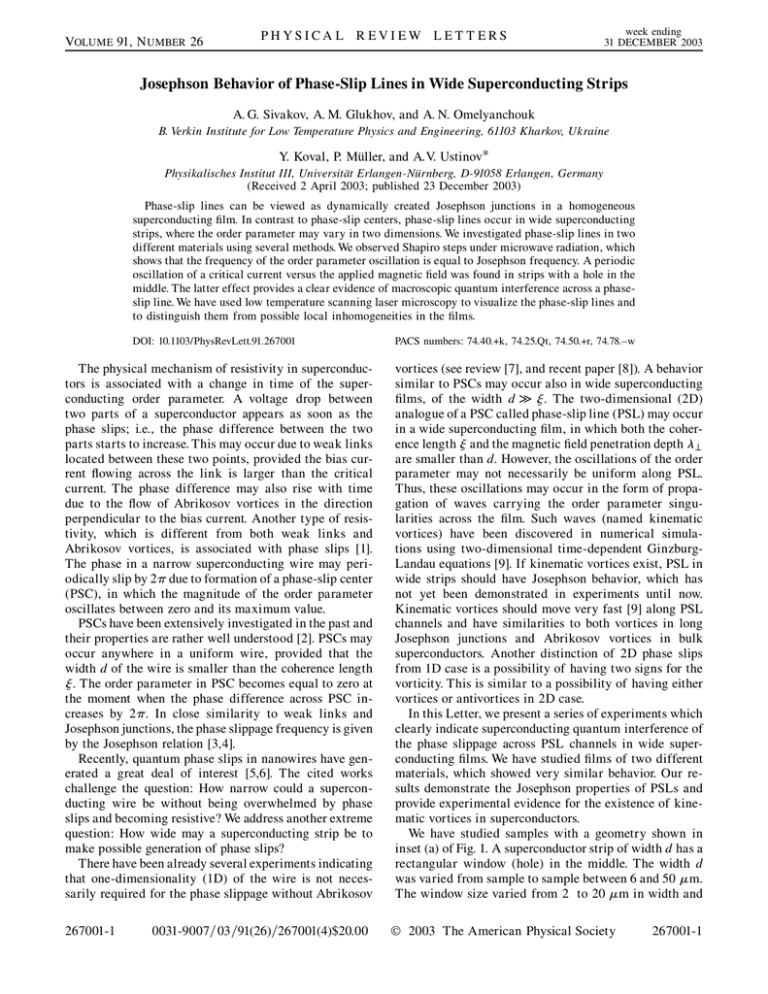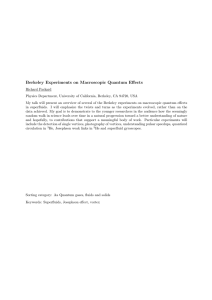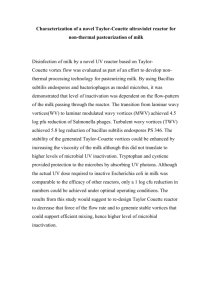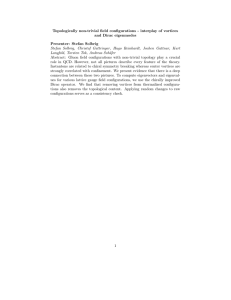Josephson Behavior of Phase-Slip Lines in Wide Superconducting Strips
advertisement

VOLUME 91, N UMBER 26 PHYSICA L R EVIEW LET T ERS week ending 31 DECEMBER 2003 Josephson Behavior of Phase-Slip Lines in Wide Superconducting Strips A. G. Sivakov, A. M. Glukhov, and A. N. Omelyanchouk B. Verkin Institute for Low Temperature Physics and Engineering, 61103 Kharkov, Ukraine Y. Koval, P. Müller, and A.V. Ustinov* Physikalisches Institut III, Universität Erlangen-Nürnberg, D-91058 Erlangen, Germany (Received 2 April 2003; published 23 December 2003) Phase-slip lines can be viewed as dynamically created Josephson junctions in a homogeneous superconducting film. In contrast to phase-slip centers, phase-slip lines occur in wide superconducting strips, where the order parameter may vary in two dimensions. We investigated phase-slip lines in two different materials using several methods. We observed Shapiro steps under microwave radiation, which shows that the frequency of the order parameter oscillation is equal to Josephson frequency. A periodic oscillation of a critical current versus the applied magnetic field was found in strips with a hole in the middle. The latter effect provides a clear evidence of macroscopic quantum interference across a phaseslip line. We have used low temperature scanning laser microscopy to visualize the phase-slip lines and to distinguish them from possible local inhomogeneities in the films. DOI: 10.1103/PhysRevLett.91.267001 The physical mechanism of resistivity in superconductors is associated with a change in time of the superconducting order parameter. A voltage drop between two parts of a superconductor appears as soon as the phase slips; i.e., the phase difference between the two parts starts to increase. This may occur due to weak links located between these two points, provided the bias current flowing across the link is larger than the critical current. The phase difference may also rise with time due to the flow of Abrikosov vortices in the direction perpendicular to the bias current. Another type of resistivity, which is different from both weak links and Abrikosov vortices, is associated with phase slips [1]. The phase in a narrow superconducting wire may periodically slip by 2 due to formation of a phase-slip center (PSC), in which the magnitude of the order parameter oscillates between zero and its maximum value. PSCs have been extensively investigated in the past and their properties are rather well understood [2]. PSCs may occur anywhere in a uniform wire, provided that the width d of the wire is smaller than the coherence length . The order parameter in PSC becomes equal to zero at the moment when the phase difference across PSC increases by 2. In close similarity to weak links and Josephson junctions, the phase slippage frequency is given by the Josephson relation [3,4]. Recently, quantum phase slips in nanowires have generated a great deal of interest [5,6]. The cited works challenge the question: How narrow could a superconducting wire be without being overwhelmed by phase slips and becoming resistive? We address another extreme question: How wide may a superconducting strip be to make possible generation of phase slips? There have been already several experiments indicating that one-dimensionality (1D) of the wire is not necessarily required for the phase slippage without Abrikosov 267001-1 0031-9007=03=91(26)=267001(4)$20.00 PACS numbers: 74.40.+k, 74.25.Qt, 74.50.+r, 74.78.–w vortices (see review [7], and recent paper [8]). A behavior similar to PSCs may occur also in wide superconducting films, of the width d . The two-dimensional (2D) analogue of a PSC called phase-slip line (PSL) may occur in a wide superconducting film, in which both the coherence length and the magnetic field penetration depth ? are smaller than d. However, the oscillations of the order parameter may not necessarily be uniform along PSL. Thus, these oscillations may occur in the form of propagation of waves carrying the order parameter singularities across the film. Such waves (named kinematic vortices) have been discovered in numerical simulations using two-dimensional time-dependent GinzburgLandau equations [9]. If kinematic vortices exist, PSL in wide strips should have Josephson behavior, which has not yet been demonstrated in experiments until now. Kinematic vortices should move very fast [9] along PSL channels and have similarities to both vortices in long Josephson junctions and Abrikosov vortices in bulk superconductors. Another distinction of 2D phase slips from 1D case is a possibility of having two signs for the vorticity. This is similar to a possibility of having either vortices or antivortices in 2D case. In this Letter, we present a series of experiments which clearly indicate superconducting quantum interference of the phase slippage across PSL channels in wide superconducting films. We have studied films of two different materials, which showed very similar behavior. Our results demonstrate the Josephson properties of PSLs and provide experimental evidence for the existence of kinematic vortices in superconductors. We have studied samples with a geometry shown in inset (a) of Fig. 1. A superconductor strip of width d has a rectangular window (hole) in the middle. The width d was varied from sample to sample between 6 and 50 m. The window size varied from 2 to 20 m in width and 2003 The American Physical Society 267001-1 VOLUME 91, N UMBER 26 PHYSICA L R EVIEW LET T ERS FIG. 1. Current-voltage (IV) characteristics of a 15 m wide Sn strip with a 5 m 15 m window in the middle shown in inset (a). Insets (b) and (c) present laser scanning microscope (LSM) images taken at points 1 and 2 of the IV curve, respectively. White arrows indicate the phase-slip lines (PSLs). from 5 to 40 m in length along the current flow direction. We also studied several samples without a window. To prepare the samples, we used electron beam lithography and metal deposition followed by lift-off. The deposition was done by thermal evaporation. Films of pure Sn and of InSn alloy with a thickness of 100 nm were investigated. In the studied temperature range (10 –30 mK below Tc ), ? was estimated to be between 3 and 5 m. The preparation technique allowed us to obtain straight and relatively uniform edges of the films. The roughness of the film edge was less than 0:1 m. This property of the samples is particularly important for keeping high enough the edge energy barrier for Abrikosov vortices. Under influence of the bias current, the Abrikosov vortices may be nucleated at the film edges due to a higher current density in these regions and because of the inhomogeneities. The vortices can be induced either by an external magnetic field or by the selffield of the current. Homogeneous edges make it possible for PSLs to appear at currents well below the current at which Abrikosov vortices start to penetrate the sample edges and flow across the strip. Typically, the measurements are done at temperatures T close to the critical temperature Tc of the superconducting material. A typical current-voltage (IV) characteristic of a sample is shown in Fig. 1. There we observe several 267001-2 week ending 31 DECEMBER 2003 features which are characteristic to PSLs: (1) a voltage jump from zero voltage at some critical current; (2) all resistive branches have approximately the same excess current (given by the intersection of their slopes with current axis); (3) the differential resistance of a resistive branch is proportional to its number. This behavior differs, for example, from the propagation of flux jumps [10]. Each voltage jump in IV curve corresponds to a generation of an additional PSL in the film. The slope increment from branch to branch depends on the electrical field penetration depth lE and is equal to the normal resistance of a 2lE -long sample section. At high currents, the distance between PSLs becomes less than 2lE and the IV curve approaches Ohmic law with the slope equal to the normal resistance of the sample. In order to verify that the observed behavior is due to PSLs, we have visualized the measured resistive states by using the technique of low temperature laser scanning microscopy (LSM) [11]. In this method, a laser beam focused in a spot of about 1:5 m in diameter is scanned over the surface of a current-biased sample. The sample voltage response to a local temperature increase induced by the laser beam is recorded as a function of the beam spot coordinates. The beam power is modulated at a frequency of some kHz and the sample voltage response (presented here in gray scale) is measured using a lock-in technique. The LSM images illustrating the appearance of PSLs in 30 m wide homogeneous Sn film are shown in Fig. 2. The images are obtained at bias current values corresponding the first, second, and third steps on IV curve [2(a) –2(c)] and in a high current region . The voltage response is maximum at PSLs and decreases in nonequilibrium regions in their vicinity. In the gray scale images, the highest response is displayed in white, so PSLs appear as bright spots crossing the strip. It is clearly seen from Fig. 2 that generation of an additional PSL leads to global rearrangement of the whole resistive structure. PSLs tend to distribute themselves uniformly along the strip. Such rearrangement in space is a characteristic feature of PSCs [12,13]. This type of behavior had been observed earlier in Ref. [14] for PSLs in wide superconducting strips. The window samples show similar behavior. Typical LSM images are presented in insets (b) and (c) of Fig. 1. Their bias points lie on the two resistive branches, corresponding to one PSL and two PSLs, respectively. At bias point 1, a PSL appears in the middle of two strips, which surround the window. Increase of the current to point 2 generates a pair of PSLs, which cross the sample through the bars defining the window. PSLs now are located close to edges of the window. We observe here resistive structures of dynamic nature (they may shift with the bias), which is the attribute of PSLs. The rf irradiation experiments were performed by coupling microwaves inductively to the samples. A typical example corresponding to a single PSL is shown in Fig. 3. It is clearly seen that current steps appear at voltages 267001-2 VOLUME 91, N UMBER 26 PHYSICA L R EVIEW LET T ERS FIG. 2. Generation of PSLs in a uniform 30 m wide Sn strip induced by the bias current increasing gradually from (a) to (d). Images (a), (b), and (c) are taken at the first, second, and third steps of the IV curve. Image (d) is obtained in a high current region. depending on radiation frequency. The step voltages obey the Josephson relation V nf0 , where 0 h=2e ’ 2:07 1015 V s is a magnetic flux quantum, f is the microwave frequency, and n is an integer. The effect of microwave radiation was observed for all strips, both with a window and without a window. By varying temperature, we were able to change the coherence length of investigated material. The coherence length was determined from measurement of the FIG. 3. IV characteristics of a 15 m wide Sn strip with 5 m 15 m window under microwave irradiation with frequency f of 0.5 GHz (1), 1 GHz (2), 2 GHz (3), 3 GHz (4), and with no microwaves (5). The zero of current for different curves is shifted as indicated on the plot. 267001-3 week ending 31 DECEMBER 2003 second critical field in all experiments. Typically, was less than 1 m, which is less than the width d of investigated strips. It means that the condition for PSL existence was fulfilled. At temperatures close to Tc , the coherence length diverges and the PSC regime with * d is realized. We have found no crossover in the resistive behavior between PSL and PSC regimes. The dependence of the critical current Ic (switching current from zero voltage branch to the first resistive branch) on magnetic field is presented in Fig. 4. One can see periodic oscillations of Ic H with a period determined by the area of the quantization contour formed by the window. Such behavior is characteristic for a twocontact interferometer [15]. The role of weak links is played here by PSLs. Strips without windows showed no oscillations. Our experiments suggest a possibility of making a dc SQUID using simply a homogeneous superconducting strip with a window. A current flowing through the device creates PSLs, which show quantum oscillations. Of course, such a SQUID will operate only in a rather narrow temperature range. An example of VH taken at different bias currents for one of the studied samples is shown in Fig. 5. The data were taken at a temperature close to Tc . The differential resistance corresponding to switching to a resistive state is here finite due to temperature fluctuations and possible noise sources. At lower temperatures, the oscillations consist of abrupt switching between zero voltage and PSL branch. The observed interference can be useful for the creation of a weak link in a superconductor with small for which it may be technologically difficult to decrease the geometrical dimension of the structure below . FIG. 4. Critical current Ic versus magnetic field H for 25 m wide Sn strips with different window sizes: (a) 5 5 m2 ; (b) 5 10 m2 ; (c) 5 15 m2 . 267001-3 VOLUME 91, N UMBER 26 PHYSICA L R EVIEW LET T ERS FIG. 5. Voltage variation versus magnetic field H at different bias currents set with increment of 0:8 A. The strip width is 30 m, the window size is 10 10 m2 . The critical current and voltage oscillations versus H were observed in a relatively wide range of temperatures. However, the oscillations exist only at small magnetic fields. This range of fields is narrower for wider strips. For width larger than 20 m, the oscillations vanish. The vanishing of the oscillations coincides with an appearance of a resistive slope emerging from the zero voltage branch of IV curve. The differential value of the slope resistance is proportional to the magnetic field, which is characteristic to flux flow of Abrikosov vortices. For wide strips with d * 20 m, the flux flow resistance can already be seen at zero magnetic field. That means that the critical current for vortices generated by the self-field of the current becomes smaller than the current of PSL formation. Thus, the oscillations of Ic H curves vanish when the flow of Abrikosov vortices sets in. The model of PSL dynamics described by the motion of kinematic vortices [9] suggests that these vortices should move very fast. Assuming roughly one vortex present in PSL at a time, we can estimate the velocity of vortices moving along PSL as vkv ’ df 105 m=s . This speed is 2 orders of magnitude higher than velocities known for Abrikosov vortices (the typical maximum speed measured for them is vAv ’ 103 m=s [16]). Even placing Abrikosov vortices at a distance equal to the coherence length (>0:2 m in our experiment) does not help to explain by them our data. At the same time, vkv is much smaller than the characteristic velocity of Josephson vortices vJv ’ 107 m=s . The physical reason for the condition vAv vkv vJv is that kinematic vortices have similarities with both Abrikosov and Josephson vortices. The effect of the order parameter relaxation in the wake of a vortex has been studied by Glazman [17]. It is energetically favorable for the core of a trailing vortex to be in the wake. The kinematic vortices are strongly anisotropic [9] as they move along PSL, 267001-4 week ending 31 DECEMBER 2003 where the order parameter in average is suppressed. PSL forms effectively a Josephson weak link, where vortices can move much faster than in the bulk superconductor. In summary, we presented here several evidences of the Josephson behavior of PSLs in superconducting strips of the width d . These observations suggest that, in spite of the fact that the order parameter may slip nonuniformly along the PSL channel, the macroscopic quantum interference between two parts of the superconductor is preserved. Thus, according to the theoretical prediction [9], a nonuniform phase slippage in such channels can be described as a motion of kinematic vortices. These vortices have similarities to both vortices in long Josephson junctions and Abrikosov vortices in bulk superconductors. We would like to thank D. Abraimov and O. Turutanov for technical help. Useful discussions with J. Free, L. Glazman, V. Kurin, V. Ryazanov, and M. Tinkham are gratefully acknowledged. *Electronic address: ustinov@physik.uni-erlangen.de † URL: http://www.physik.uni-erlangen.de/pi3/ustinov [1] M. Tinkham, Introduction to Superconductivity (McGraw-Hill, New York, 1996), 2nd ed. [2] B. I. Ivlev and N. B. Kopnin, Usp. Fiz. Nauk 142, 435 (1984) [Sov. Phys. Usp. 27, 206 (1984)]. [3] W. J. Skocpol, M. R. Beasley, and M. Tinkham, J. Low Temp. Phys. 16, 145 (1974). [4] V. I. Kuznetsov and V. A. Tulin, Sov. Phys. JETP 86, 1364 (1998). [5] A. Bezryadin , C. N. Lau, and M. Tinkham, Nature (London) 404, 971 (2000). [6] C. N. Lau, N. Markovic, M. Bockrath, A. Bezryadin, and M. Tinkham, Phys. Rev. Lett. 87, 217003 (2001). [7] I. M. Dmitrenko, Low Temp. Phys. 22, 648 (1996). [8] A. B. Agafonov, I.V. Zolochevkii, E.V. Khristenko, and V. M. Dmitriev, Low Temp. Phys. 27, 686 (2001). [9] A. Andronov, I. Gordion, V. Kurin, I. Nefedov, and I. Shereshevsky, Physica (Amsterdam) 213C, 193 (1993). [10] R. P. Huebener and D. F. Gallus, Phys. Lett. A 44, 443 (1973); D. E. Chimenti and R. P. Huebener, Solid State Commun. 21, 467 (1977). [11] A. G. Sivakov, A. P. Zhuravel’s, O. G. Turutanov, and I. M. Dmitrenko, Appl. Surf. Sci. 106, 390 (1996). [12] M. Tinkham, J. Low Temp. Phys. 35, 147 (1979). [13] A. A. Abrikosov, Fundamentals of the Theory of Metals (North-Holland, Amsterdam, 1988). [14] A. P. Zhuravel’s, A. G. Sivakov, O. G. Turutanov, and I. M. Dmitrenko, Czech. J. Phys. 46, 643 (1996). [15] A. Barone and G. Paterno, Physics and Applications of the Josephson Effect (Wiley, New York, 1982). [16] S. G. Doettinger, S. Kittelberger, R. P. Huebener, and C. C. Tsuei, Phys. Rev. B 56, 14 157 (1997). [17] L. I. Glazman, Fiz. Nizk. Temp. 12, 688 (1986) [Sov. J. Low Temp. Phys. 12, 389 (1986 )]. 267001-4



